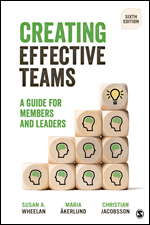Creating Effective Teams
A Guide for Members and Leaders
Sixth Edition
Susan A. Wheelan - GDQ Associates, Inc.
Christian Jacobsson - GDQ Associates AB
Maria Åkerlund - GDQ Associates AB
Susan A. Wheelan - GDQ Associates, Inc.
Christian Jacobsson - GDQ Associates AB
Maria Åkerlund - GDQ Associates AB
168 pages
| July, 2020
| SAGE Publications, Inc
Instant Access!
eBook
ISBN: 9781544332963
Paperback
ISBN: 9781544332970
$65.00
Instant Access!
eBook
ISBN: 9781544332963
A practical guide for building and sustaining top-performing teams
Based on the authors' many years of consulting experience with teams in the public and private sectors, Creating Effective Teams: A Guide for Members and Leaders describes why teams are important, how they function, and what makes them successful. The texts covers the four stages of team development —forming, storming, norming, and performing— to help readers effectively navigate these different phases. Separate chapters are devoted to the responsibilities of team leaders and team members. Susan A. Wheelan, Maria Akerlund, and Christian Jacobsson highlight common problems that occur frequently in groups as well as provide practical tips, real-life examples, and questionnaires to help address those problems.
Based on the authors' many years of consulting experience with teams in the public and private sectors, Creating Effective Teams: A Guide for Members and Leaders describes why teams are important, how they function, and what makes them successful. The texts covers the four stages of team development —forming, storming, norming, and performing— to help readers effectively navigate these different phases. Separate chapters are devoted to the responsibilities of team leaders and team members. Susan A. Wheelan, Maria Akerlund, and Christian Jacobsson highlight common problems that occur frequently in groups as well as provide practical tips, real-life examples, and questionnaires to help address those problems.
Available formats
ISBN: 9781544332963
eBook
Suggested Retail Price: $26.00
Bookstore Price: $20.80
ISBN: 9781544332963
eBook
Suggested Retail Price: $30.00
Bookstore Price: $24.00
ISBN: 9781544332963
eBook
Suggested Retail Price: $33.00
Bookstore Price: $26.40
ISBN: 9781544332963
eBook
Suggested Retail Price: $47.85
Bookstore Price: $38.28
ISBN: 9781544332970
Paperback
Suggested Retail Price: $65.00
Bookstore Price: $52.00
See what’s new to this edition by selecting the Features tab on this page. Should you need additional information or have questions regarding the HEOA information provided for this title, including what is new to this edition, please email sageheoa@sagepub.com. Please include your name, contact information, and the name of the title for which you would like more information. For information on the HEOA, please go to http://ed.gov/policy/highered/leg/hea08/index.html.
For assistance with your order: Please email us at textsales@sagepub.com or connect with your SAGE representative.
SAGE
2455 Teller Road
Thousand Oaks, CA 91320
www.sagepub.com
Preface
About the Authors
Groups Have a Long History of Success
We Need Groups Every Day
Groups Increase Our Knowledge Base
When Teams Are Good, They’re Very, Very Good
Creating Effective Teams
How to Use This Book
Plant Groups in a Favorable Organizational Climate
Give Groups What They Need to Do Their Best
Pick Members Based on Their Ability to Do the
Task and Their Ability to Contribute to Group Success
Educate People for Group Participation Competence
Avoid Unsubstantiated Team Development and Consultation Strategies
Avoid Helping Groups Too Much
Make Sure Each Group Has Enough Autonomy to Do Its Work but Remains Connected With the Rest of the Organization
Conduct Organizational Support Reviews Regularly
The Organizational Support Checklist
Stage 1: Dependence and Inclusion
Stage 2: Counterdependence and Fighting
Stage 3: Trust and Structure
Stage 4: Work and Productivity
Surviving Group Development
The Characteristics of High Performance Teams
Ten Keys to Productivity
Team Performance Checklist
Don’t Blame Others for Group Problems
Encourage the Process of Goal, Role, and Task Clarification
Encourage the Adoption of an Open Communication Structure in Which All Member Input and Feedback Are Heard
Promote an Appropriate Ratio of Task and Supportive Communications
Promote the Use of Effective Problem-Solving and Decision-Making Procedures
Encourage the Establishment of Norms That Support Productivity, Innovation, and Freedom of Expression
Go Along With Norms That Promote Group Effectiveness and Productivity
Promote Group Cohesion and Cooperation
Effective Member Checklist
Don’t Take On Every Leadership Assignment You Are Offered
Adjust Your Leadership Style to Meet the Developmental Needs of the Group at a Particular Time
Leadership at Stage 1: Be a Directive and Confident Leader
Leadership at Stage 2: When Members Begin to Demand More Participation in Running the Group, Slowly Begin to Empower Them
Leadership at Stage 3: Involve Members in the Leadership Function
Leadership at Stage 4: Participate as an Expert Member of Your Team
Effective Leader Checklist
Goals of Stage 1
Concerns About Safety and Inclusion
Dependence on the Designated Leader
A Wish for Order and Structure
Goals of Stage 2
Create a Unified Group Culture
Create a Unified and Effective Group Structure
Goals of Stage 3
Fine-Tuning Roles, Organization, and Procedures
Solidifying Positive Relationships
Goals of Stage 4
Getting the Work Done Well
Making Decisions
Cohesion and Conflict
Maintaining High Performance
Fluid Teams
Self-Managed Teams
Agile Teams
Virtual Teams
Multicultural Teams
Does the Model Describe What Really Happens in Groups?
How Are Groups Distributed Across the Four Stages?
On Average, How Long Does the Development Process Take?
Does Team Building Have Any Effect?
Does Group Size Affect Group Maturity?
How Do Work Groups in Different Sectors Function?
A Final Thought
Bibliography
Index
New to this Edition:
- New Chapter 11 on Changes in Team Functioning explores the benefits and challenges of working on fluid teams, self-managed teams, agile teams, virtual teams, and multicultural teams.
- A significantly revised Chapter 12 highlights the latest research on the integrated model of group development.
- New and updated research throughout
- Packed with straightforward strategies for building and supporting well-managed, high-performing teams, this book examines why teams are important, how they function, and what makes them productive.
- Checklists and self-evaluations provide even more information on the reader’s personal leader or team member style.
- Research references provide readers with the theory and research background for the practical, application-based material in the text.

